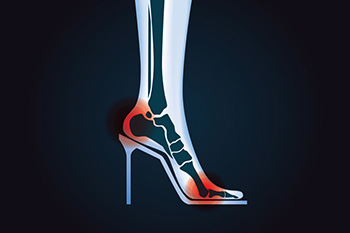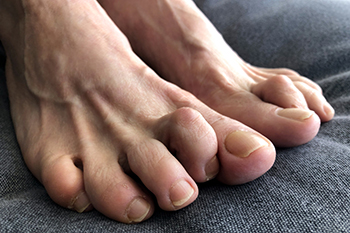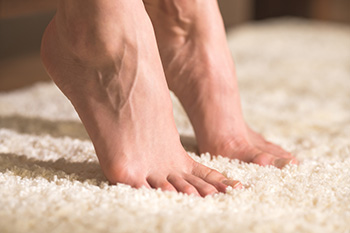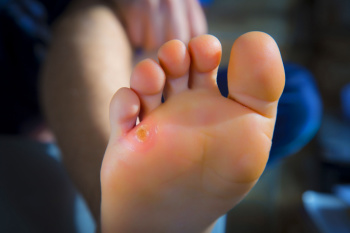Items filtered by date: January 2025
Why Wearing High Heels May Cause Foot Pain

Wearing high heels can lead to a variety of foot problems due to the unnatural positioning and pressure they place on the feet. High heels force the toes into a confined space and push the body’s weight forward, increasing pressure on the toes and the ball of the foot. This can lead to painful conditions such as bunions, corns, and calluses. Over time, wearing high heels can also cause shortening and tightening of the Achilles tendon, leading to Achilles tendinitis or heel pain. Additionally, the elevated heel alters the natural alignment of the spine and joints, potentially causing back and knee pain. High heels can also contribute to the development of plantar fasciitis due to the strain they place on the bottom of the foot. While wearing high heels occasionally may not cause immediate harm, frequent use can lead to long-term foot and joint problems. If you have foot pain from wearing high heels, it is suggested that you confer with a podiatrist who can treat various foot conditions, and educate you on more appropriate shoes to wear.
High heels have a history of causing foot and ankle problems. If you have any concerns about your feet or ankles, contact Nrup Tolat, DPM from Atlanta Total Foot & Ankle Care. Our doctor can provide the care you need to keep you pain-free and on your feet.
Effects of High Heels on the Feet
High heels are popular shoes among women because of their many styles and societal appeal. Despite this, high heels can still cause many health problems if worn too frequently.
Which Parts of My Body Will Be Affected by High Heels?
- Ankle Joints
- Achilles Tendon – May shorten and stiffen with prolonged wear
- Balls of the Feet
- Knees – Heels cause the knees to bend constantly, creating stress on them
- Back – They decrease the spine’s ability to absorb shock, which may lead to back pain. The vertebrae of the lower back may compress.
What Kinds of Foot Problems Can Develop from Wearing High Heels?
- Corns
- Calluses
- Hammertoe
- Bunions
- Morton’s Neuroma
- Plantar Fasciitis
How Can I Still Wear High Heels and Maintain Foot Health?
If you want to wear high heeled shoes, make sure that you are not wearing them every day, as this will help prevent long term physical problems. Try wearing thicker heels as opposed to stilettos to distribute weight more evenly across the feet. Always make sure you are wearing the proper shoes for the right occasion, such as sneakers for exercising. If you walk to work, try carrying your heels with you and changing into them once you arrive at work. Adding inserts to your heels can help cushion your feet and absorb shock. Full foot inserts or metatarsal pads are available.
If you have any questions please feel free to contact our offices located in Woodstock and Atlanta, GA . We offer the newest diagnostic and treatment technologies for all your foot and ankle needs.
Causes and Symptoms of Hammertoe

Hammertoe is a deformity of the toe in which the middle joint becomes bent downward, creating a hammer-like appearance. This condition most often affects the second, third, or fourth toes. Hammertoe can develop due to an imbalance in the muscles, tendons, or ligaments that control the toe’s movement. Causes include wearing ill-fitting shoes that crowd the toes, especially high heels, or inherited foot structure. Conditions such as arthritis, diabetes, or neurological disorders can also contribute to the development of hammertoe. Symptoms of hammertoe include pain or discomfort in the affected toe, especially when walking or wearing shoes. The toe may appear bent, and the joint may become stiff or rigid over time. Corns or calluses can also form on the top or tips of the affected toes due to friction with footwear. Hammertoe can be uncomfortable and unsightly. If you have developed this condition, it is suggested that you consult a podiatrist who can offer effective relief and treatment solutions.
Hammertoe
Hammertoes can be a painful condition to live with. For more information, contact Nrup Tolat, DPM from Atlanta Total Foot & Ankle Care. Our doctor will answer any of your foot- and ankle-related questions.
Hammertoe is a foot deformity that affects the joints of the second, third, fourth, or fifth toes of your feet. It is a painful foot condition in which these toes curl and arch up, which can often lead to pain when wearing footwear.
Symptoms
- Pain in the affected toes
- Development of corns or calluses due to friction
- Inflammation
- Redness
- Contracture of the toes
Causes
Genetics – People who are genetically predisposed to hammertoe are often more susceptible
Arthritis – Because arthritis affects the joints in your toes, further deformities stemming from arthritis can occur
Trauma – Direct trauma to the toes could potentially lead to hammertoe
Ill-fitting shoes – Undue pressure on the front of the toes from ill-fitting shoes can potentially lead to the development of hammertoe
Treatment
Orthotics – Custom made inserts can be used to help relieve pressure placed on the toes and therefore relieve some of the pain associated with it
Medications – Oral medications such as anti-inflammatories or NSAIDs could be used to treat the pain and inflammation hammertoes causes. Injections of corticosteroids are also sometimes used
Surgery – In more severe cases where the hammertoes have become more rigid, foot surgery is a potential option
If you have any questions please contact our offices located in Woodstock and Atlanta, GA . We offer the newest diagnostic and treatment technologies for all your foot and ankle needs.
Are You Suffering From Ingrown Toenails?
Giving Your Feet a Workout

Keeping your feet, toes, and ankles strong and flexible can help alleviate pain and reduce the risk of injuries. Simple foot exercises, like standing heel raises or toe spreading, improve strength and stability, while stretches such as the Achilles tendon stretch enhance flexibility. Balance exercises, like standing on one foot, also play a role in building ankle stability. Ankle rotations or writing the alphabet with your big toe can increase joint mobility and coordination. These activities are particularly helpful for addressing issues in the feet, toes, and ankles caused by strain or stiffness. If you experience difficulty performing these exercises or are unsure of where to begin, a podiatrist can assess your specific needs and offer guidance on suitable exercises. This foot doctor can also identify other issues that may require further treatment to prevent ongoing discomfort or injury. If you regularly experience aches and pains in your feet, it is suggested that you schedule an appointment with a podiatrist for an exam and treatment.
Exercising your feet regularly with the proper foot wear is a great way to prevent injuries and build strength. If you have any concerns about your feet, contact Nrup Tolat, DPM from Atlanta Total Foot & Ankle Care. Our doctor can provide the care you need to keep you pain-free and on your feet.
Exercise for Your Feet
Exercise for your feet can help you gain strength, mobility and flexibility in your feet. They say that strengthening your feet can be just as rewarding as strengthening another part of the body. Your feet are very important, and we often forget about them in our daily tasks. But it is because of our feet that are we able to get going and do what we need to. For those of us fortunate enough to not have any foot problems, it is an important gesture to take care of them to ensure good health in the long run.
Some foot health exercises can include ankle pumps, tip-toeing, toe rises, lifting off the floor doing reps and sets, and flexing the toes. It is best to speak with Our doctor to determine an appropriate regimen for your needs. Everyone’s needs and bodies are different, and the activities required to maintain strength in the feet vary from individual to individual.
Once you get into a routine of doing regular exercise, you may notice a difference in your feet and how strong they may become.
If you have any questions please feel free to contact our offices located in Woodstock and Atlanta, GA . We offer the newest diagnostic and treatment technologies for all your foot and ankle needs.
What Happens to an Untreated Corn

A corn is a thickened, hardened area of skin that forms on the foot due to pressure or friction. If left untreated, a corn can become painful, inflamed, and prone to infection. The symptoms of an untreated corn typically include tenderness, redness, and swelling surrounding the affected area. Over time, corns may become larger making it difficult to wear shoes comfortably. The main causes of corns include wearing ill-fitting shoes that do not provide enough support, excessive pressure from walking or standing, and abnormal foot mechanics like a misalignment of the toes. Untreated corns can lead to complications such as infections, especially if the skin becomes cracked. Corns can be painful. If you have developed a corn, it is suggested that you schedule an appointment with a podiatrist who can offer appropriate relief and treatment methods.
If you have any concerns regarding your feet and ankles, contact Nrup Tolat, DPM of Atlanta Total Foot & Ankle Care. Our doctor will treat your foot and ankle needs.
Corns: What Are They? and How Do You Get Rid of Them?
Corns can be described as areas of the skin that have thickened to the point of becoming painful or irritating. They are often layers and layers of the skin that have become dry and rough, and are normally smaller than calluses.
Ways to Prevent Corns
There are many ways to get rid of painful corns such as wearing:
- Well-fitting socks
- Comfortable shoes that are not tight around your foot
- Shoes that offer support
Treating Corns
Treatment of corns involves removing the dead skin that has built up in the specific area of the foot. Consult with Our doctor to determine the best treatment option for your case of corns.
If you have any questions please feel free to contact our offices located in Woodstock and Atlanta, GA . We offer the newest diagnostic and treatment technologies for all your foot and ankle needs.

